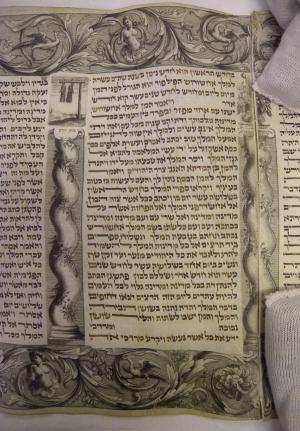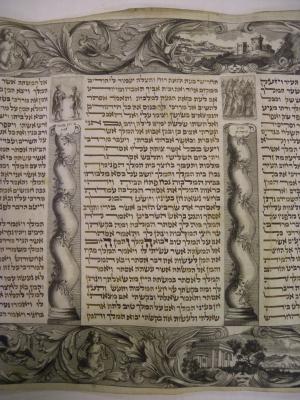Obj. ID: 38112
Hebrew Illuminated Manuscripts JMNY Franck Esther Scroll, Prague (?), ca. 1700

This scroll is adorned with an engraved border designed by Philipp Jakob Franck in which the Hebrew text of the Book of Esther is hand-copied by a scribe.
It starts with a panel composed of a crown-topped cartouche, supported by two standing angels and three scenes from the Book of Esther placed one under the other. Elongated cartouches for the Hebrew inscriptions are added to the scenes. The illustrations are labeled, but their wording is not the same in all surviving versions of this type of megillah. Additionally, there is an inscription in the lower-left corner of the second illustration in the Latin alphabet (see "Signature").
The upper and lower margins of the entire scroll are decorated with the same pattern, a composition of dense acanthus leaves in which nude busts, landscapes framed in decorative cartouches, and birds (possibly phoenixes) are woven.
The text of the megillah is inscribed in rectangular panels separated by twisted columns. Just above each column are flower-filled vases and narrative scenes from the Purim story (their sequence is not the same in all preserved exemplars of this type of scroll). Four other narrative scenes from the Book of Esther are printed one under the other at the end of the scroll. In the second and third scenes, elongated cartouches for inscriptions are incorporated.
The scroll is mounted on a wooden roller.
Around 15 megillot featuring the same border are housed in private and institutional collections. Yet another exemplar used to be a part of the Gross Family Collection (no. 081.012.044) but in 2003, it was stolen from the Beit Hatfutsot Museum in Tel Aviv (Hilfe erbeten: Judaica Diebstahl: http://www.judentum.net; accessed on 14.12.2018).
There are also two scrolls embellished with the same border but with texts other than the Book of Esther.
sub-set tree:
C | Columns | Twisted columns
L | Landscape
E | Esther, Book of (following the order of the story) | Esther story protagonists
A | Acanthus Leaf
W | Woman | Nude
H | Human Figure | Bust (Human figure)
V | Vase | Vase with flowers
O | Ornamentation: | Foliate and floral ornaments
B | Bird
P | Phoenix
A | Angel , (Sandalfon (angel)), (Metatron (angel))
|
Length of the sheets in the scroll: 1) 670 mm, 2) 585 mm, 3) 595 mm, 4) ca. 515 mm.
An average letter is 3 mm high as well as spaces between the subsequent lines of the text.
For dimensions of other details in the scroll see ID 37869.
The roller: 450 mm (height).
In general, the manuscript is preserved in good condition, although the print in the opening section is slightly damaged; slight damages in other parts of the prints can be seen too.
The text is well preserved in the scroll.
There are some stains on the membranes.
The upper edges of the membranes are not straight.
The traces of metal plates are well visible on the blank side of parchment membranes.
The Book of Esther in Hebrew
The scroll is formed of 4 sheets containing a total of 15 columns of text with 28 lines each, except for col. 13 which has 11 lines divided into two half-columns.
Membranes nos. 1-3 contain 4 columns of the text and the fourth membrane includes 3 columns.
The text is inscribed in the Hebrew square Ashkenazi script with tagin in brown and black ink on the flesh side of parchment membranes that are rather thick, grey, and suede.
The letters ח (Es. 1:6) and ת (Es. 9:29) are enlarged and bolded. Other enlarged and diminished letters are included in col. 13. Additionally, in cols. 2, 7, 8, and 10 enlarged and bolded letters marking the Tetragrammaton can be seen.
The ruling - made with a hard point along with the sheets - is barely visible, in some places only.
The pricking is invisible.
The membranes in the scroll are stitched together.
The cartouche supported by angels, in the upper part of the opening panel, is filled with a Hebrew inscription of the previous owner of the scroll, Moses:
מגילה זאת שייך ... משה
The scrolls featuring the same border are described in:
Dagmara Budzioch, Verzierte Ester-Rollen – illustriert von dem Prager Kupferstecher Philipp Jakob Franck [in:] Zwischen Offenbarung und Kontemplation: Die Wolfenbütteler hebräischen Schriftrollen, mit Beiträgen von Dagmara Budzioch und Ad Stijnman (Wolfenbütteler Forschungen), Wiesbaden 2021, pp. 106-117.
A Journey through Jewish Worlds: Highlights from the Braginsky Collection of Hebrew Manuscripts and Printed Books, eds. Evelyn M. Cohen, Emile Schrijver, Sharon Mintz, Amsterdam 2009, 266–267.
http://braginskycollection.com/scrolls/prague/ (accessed on 21.09.2020).
A Magnificent Illustrated Esther Scroll [Prague ca. 1700], lot 169: http://www.sothebys.com; accessed on 14.12.2018.
A Magnificent Illustrated Esther Scroll [Prague: ca. 1700], lot 24: http://www.sothebys.com; accessed on 14.12.2018.





















